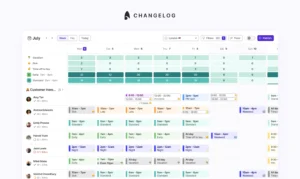
A complete guide to workforce forecasting 2023

Consider a captain in control of a majestic ship crossing risky waters.
To arrive at the destination smoothly, the captain must have extensive knowledge of the sea, the climate and the crews’ skills. Similarly, team leads and managers must be able to foresee and navigate through the ebbs and flows of their employees.
This is where you need workforce forecasting.
In this post, we’ll delve into the complexities of forecasting in workforce management – its essential components, stages, best practices and approaches for predicting a workforce’s future composition.
What is workforce forecasting?
Workforce forecasting is a strategic practice that involves analysing historical data, current patterns, and external factors to estimate a company’s future workforce composition and requirements.
Forecasting in workforce management involves systematically overseeing talent flow within an organisation to efficiently handle the recruitment, training, development, and succession of employees well-aligned with the organisational culture and goals.
Recognising the significance of this requirement, organisations must prioritise workforce forecasting. It is critical to fill the gap observed by Oxford Economics, in which just 34% of organisations made considerable headway in developing a future-ready workforce. In addition, employing rigorous forecasting practices can help businesses effectively coordinate their staff strategy.
4 key elements of workforce forecasting
Here are four key elements that must be considered for an organisation’s effective workforce forecasting strategy. Let’s dig into the aspects of workforce management forecasting in detail.
1. Demand planning
Demand planning determines an organisation’s future staff needs based on company growth forecasts, expansion plans, new initiatives and changes in the marketplace. Its purpose is to identify the number and quality of talent needed to satisfy the organisation’s goals and objectives. Organisations may match their talent acquisition strategy with projected demand, ensuring they have enough employees at the right time. TechTarget states that meeting a product’s demand is paramount since failure could result in revenue loss or loss of consumers.
For instance, a software development enterprise may anticipate higher demand for data scientists and AI professionals due to the rising trend of integrating machine learning technology into their products. Therefore, the organisation may proactively organise its hiring efforts to acquire top personnel by analysing market estimates and consumer requests.
2. Historical data analysis
Historical data analysis includes reviewing past workforce trends, staff turnover rates, employing patterns, and other related information to find insights and possible future scenarios. Organisations can get significant insights into worker behaviour, predict future talent requirements, and make educated choices by analysing past information.
For example, historical data analysis can indicate a seasonal rise in customer service queries, highlighting the need for more temporary workers during specific seasons. By utilising this data, organisations can anticipate their recruiting and staffing methods to provide enough support coverage at peak periods, optimising customer happiness and operational effectiveness.
3. Internal supply analysis
Internal supply analysis means analysing the organisation’s existing talent pool. This comprises evaluating current workers’ abilities, competencies, expertise and ability to assess if they can perform future tasks and duties. In addition, it assists in identifying any skill gaps or places where improvement and training might be required.
Organisations can leverage their current talent and encourage internal advancement by undertaking internal supply analysis, supporting employee growth, and lowering recruiting expenses. A manufacturing company, for example, can recognise individuals with leadership abilities and provide them with learning and growth opportunities in preparation for future management positions. This method improves staff retention and fosters an internal talent development culture.
The following outcomes can be achieved with the internal supply analysis method:
- Identify the most significant skill gaps, prioritising vital tasks, and challenging positions.
- Establish a targeted replacement strategy that ensures successful knowledge transfer for essential positions.
- Engage in proactive recruiting to fill talent gaps and seek suppliers.
- Prepare for future available roles by taking advantage of developmental opportunities and raises.
- Create attrition programs to handle staff cuts for positions that require fewer people.
4. Gap analysis and action planning
An essential element in enhanced workforce forecasting is gap analysis, which involves assessing the gap between talent needs and talent availability within a company. Any gaps or incompatibilities can be found by comparing projected talent demands established via demand forecasting with the available skill pool recognised by internal supply analysis.
Once gaps have been identified, plan your actions. Action planning involves creating strategies and plans to close the demand-supply gap which could include, recruitment initiatives, training and development programs, acquiring talent partnerships, succession strategy and external talent sourcing.
Why does workforce forecasting matter?
Businesses can gain an edge over their competitors, optimise personnel management, and generate long-term growth by predicting future talent demands.
Here are a few reasons why workforce forecasting is essential:
Strategic workforce planning
Workforce forecasting is critical in strategic workforce planning. It provides organisations with a way to match staff demands with long-term business objectives. It helps companies determine crucial skill deficits, forecast future labour needs, and create focused recruitment, training, and succession programs. As a result, organisations can keep up with the competition and maintain an enduring talent stream by proactively preparing their staff members.
Talent retention and development
Workforce forecasting allows companies to engage in employee retention and development programs and project future talent demands. Organisations can actively establish programs to upskill and improve their existing staff by recognising possible skill shortages or gaps. It increases employee engagement and satisfaction and lowers the turnover rate by giving options for growth and career advancement within the organisation.
Agility and adaptability
Workforce planning enables businesses to foresee market shifts, consumer needs, and technology improvements, enabling them to adapt workforce skill sets actively. Companies that are flexible in their staff planning may adapt quickly to new possibilities, manage risks, and remain viable in an ever-changing environment.
Efficient workforce deployment
Businesses may strategically assign employees to tasks, divisions, or areas if they can effectively estimate future talent demands. It ensures that the right people with the right talents are in the right place at the right time, maximising efficiency, minimising obstacles, and enhancing operational effectiveness.
Workforce forecasting techniques
Several workforce forecasting techniques exist to foresee and estimate a company’s future workforce needs. Here are a few of them:
1. The Delphi technique
The Delphi approach is a workforce management forecasting model that gathers professionals’ viewpoints, generally through questionnaires and responses. The experts’ forecasts and views are provided anonymously, and the findings are collected and discussed with the selected panel of experts for further improvement. This iterative approach is repeated until a consensus is reached. The Delphi approach reduces prejudice and enables the incorporation of multiple viewpoints, leading to more reliable workforce projections.
2. Managerial analysis
Managerial analysis is based on the knowledge and judgement of the organisation’s managers and executives. They give assessments and feedback depending on their expertise, understanding of the marketplace, and awareness of the company’s objectives and plans. This method taps into important decision-makers’ collective wisdom and perspectives, including their tacit knowledge of the forecasting method.
3. Workload analysis
Workload analysis determines the workload needs of different jobs and divisions within an organisation. This study of forecasting models for future workforce needs considers job volume, complexity, and skill needs. As a result, companies can efficiently meet their future staffing requirements by evaluating workload expectations and determining appropriate staff size and allocation of resources.
4. Historical analysis
Historical analysis involves reviewing previous workforce data, such as staff demographics, attrition rates, recruitment patterns, and performance indicators. Companies may develop accurate estimates about future talent requirements by recognising trends, practices, and interactions in past data. This method assumes that past patterns will repeat themselves or give an understanding of future workforce patterns.
5. Advanced quantitative techniques
Advanced quantitative techniques foresee future talent requirements using complex statistical methods like regression analysis, analysis of time series, or predictive modelling. These methods use historical and quantitative information to detect relationships, create estimates, and forecast future workforce needs.
Surfboard provides an advanced solution called integrated forecasting to improve your company’s workforce planning abilities. Surfboard’s integrated forecasting allows you to leverage the value of historical ticket data to make automated and accurate estimates for your workforce requirements. This unique tool simplifies forecasting and gives detailed insights, allowing you to make data-driven decisions easily.
Easily integrate your existing tools – You can fully utilise the value of your previous ticket data by effortlessly integrating your present customer service platforms into Surfboard. Its integrated forecasting analyses this data using advanced algorithms, discovering trends, patterns, and interconnections. Surfboard provides exact staffing estimates based on this information, providing a comprehensive picture of your future personnel needs.
Automates the whole process with ease- The simplicity of Surfboard’s integrated forecasting is one of its primary benefits. It automates the forecasting procedure, saves time and effort, and removes the possibility of mistakes.
Customisable- Surfboard’s integrated forecasting allows for extensive customisation. For example, you can set service targets for every ticket category to connect your personnel planning with goals and objectives. Additionally, Surfboard enables you to deploy resources to multiple client channels. You may change staffing levels depending on ticket types, ensuring optimal workforce planning.
Steps to workforce forecasting
The steps to workforce forecasting are given below:
1. Define your business strategy:
Outline your company’s objectives, budget, and criteria to create a three to five-year strategic plan.
You must evaluate the below pointers to understand how you define your current workforce properly.
- What are our options now?
- What are the key roles?
- What are the necessary skills?
- What are their goals?
- Where are they coming from?
2. Assess workforce supply:
Assess your existing talent pool, considering both present workers and future recruits, to better understand your company’s human resources.
3. Estimate workforce demand:
Establish the number of people required to satisfy current company demands using a call centre forecasting calculator and fit your strategic goals, ensuring the workforce is suitably staffed and skilled.
4. Create a comprehensive workforce plan:
Evaluate worker demand and supply for your strategic objectives. Then, analyse gaps or discrepancies and devise plans to close them, considering recruiting, training, realignment, and other appropriate techniques.
5. Implement the workforce plan:
Put the workforce plan into action by employing more people. Employ temporary staff or contractors, use technology solutions, or reorganise departments and teams to fulfill company demands more efficiently.
6. Track and monitor progress:
Constantly assess the effect of implemented workforce changes to ensure they are aligned with the targeted results. Analyse the success of the personnel strategy regularly, making appropriate forecast adjustments to ensure alignment with the company’s goals.
5 workforce forecasting best practices
With these best practices, you can unleash the power of workforce forecasting, maximising human potential and driving organisational success.
1. Set KPIs
Set KPIs to monitor the effectiveness of call centre workforce management forecasting strategies, such as employee headcount, retention rate, advancement rate, tenure, quality of hiring, voluntary vs. involuntary departure rate, eNPS, and diversification indications.
2. Make it a collaborative process:
Include essential stakeholders in the forecasting process, such as HR experts, department managers, and executives. Collaborative input offers a complete picture of workforce requirements and connects projected needs with the company’s objectives.
3. Constantly evaluate and adjust:
Forecasting the workforce is a continual task. Track and assess your projections versus actual results regularly, and make modifications as appropriate. To optimise personnel planning and utilisation of resources, be flexible and adjust to evolving conditions.
4. Enhance talent management strategies:
Workforce forecasting should be integrated with talent management activities such as recruiting, learning, development, and retention programs. By coordinating these tactics, you can ensure a smooth shift from forecast to execution, maximising the efficacy of your personnel planning efforts.
5. Leverage data:
Use data to your advantage in call centre staff management forecasts. Using data, you may make informed judgements and give solid explanations for staffing strategies. To acquire essential insights and efficiently drive your workforce planning process, analyse critical indicators such as existing staffing numbers, retention rates, promotion rates, time-to-hire times, and other crucial variables.
By incorporating Surfboard’s advanced forecasting capabilities, Bloom & Wild witnessed a remarkable 33% improvement in their forecasting performance. In addition, their mean absolute percentage error (MAPE), which measures the variance between predicted and actual ticket volumes, averaged 12% since adopting Surfboard. This case study exemplifies how Surfboard’s integration with companies like Bloom & Wild can drive exceptional results and transform how organisations forecast their workforce needs.
Workforce forecasting and scheduling with Surfboard
Effective labour management is possible with the appropriate forecasting and scheduling tools. Surfboard can help you streamline company processes, optimise growth, and prepare for success. We assist companies like yours to succeed by leveraging our years of knowledge and tailor-made solutions.
Book a demo to learn more about how Surfboard can suit your specific requirements and drive your organisation ahead.
FAQs
Why is workforce forecasting important in organisations?
Organisations rely on workforce forecasting to predict and solve the gap between future job demand and capacity. As a result, organisations may bridge the workforce management gap and achieve optimum workforce management by correctly estimating personnel needs.
What are the 3 kinds of forecasting methods in workforce forecasting?
The three forecasting methods in workforce forecasting are:
- Qualitative method
- Time series
- Causal models
Which forecasting method is the best?
While quantitative forecasting methods based on historical data are often the most precise, they do not perform well for long-term projections. Instead, try qualitative forecasting approaches that depend on expert views rather than company-specific facts if you want to anticipate across several years.



